Effects of Independent and Combined Water-Deficit and High-Nitrogen Treatments on Flag Leaf Proteomes during Wheat Grain Development
Abstract
1. Introduction
2. Results
2.1. Changes in Flag Leaf Physiological Characteristics and Agronomic Traits under Field Treatments
2.2. Flag Leaf Proteome Changes in Response to Water-Deficit, High-N Fertilizer, and Combined Treatments
2.3. Functional Classification and Subcellular Localization of DAPs
2.4. Dynamic Expression Profiling of DAPs during Grain Development
2.5. Comparison of Transcription and Translation Expression Levels of Key DAPs During Grain Development
3. Discussion
3.1. DAPs Involved in Water-Deficit Response
3.2. DAPs Participated in High-N Response
3.3. DAPs Responsive to Combining Water-Deficit and High-N Treatments
3.4. A Putative Synergistic Response Network Under Water-Deficit and High-N Conditions
4. Materials and Methods
4.1. Wheat Materials, Field Trials, and Sampling
4.2. Measurements of Flag Leaf Physiological Parameters and Grain Yield
4.3. Protein Extraction, 2-DE, and Image Analysis
4.4. Protein Identification Using MALDI-TOF/TOF-MS
4.5. Bioinformatic Analysis
4.6. Acquisition of the DAP Genes and Subcellular Localization
4.7. mRNA Extraction, cDNA Synthesis and RT-qPCR
5. Conclusions
Supplementary Materials
Author Contributions
Funding
Conflicts of Interest
Abbreviations
| DAP | Differentially accumulated protein |
| DPA | Day post-anthesis |
| RWC | Relative water content |
| MDA | Malondialdehyde |
| TGW | Thousand grain weight |
| Pn | Net photosynthesis efficiency |
| 2-DE | Two-dimensional gel electrophoresis |
| GFP | Green fluorescent protein |
| GAPDH | Glyceraldehyde 3-phosphate dehydrogenase |
| DHAR | Dehydroascorbate reductase |
| BAS1 | 2-Cys peroxiredoxin BAS1 |
| PPO | Polyphenol oxidase |
| FBA | Fructose-1,6-bisphosphate aldolase |
| RBSC | Ribulose-1,5-bisphosphate carboxylase/oxygenase small subunit |
| PRK | Phosphoribulokinase |
| PGK | Phosphoglycerate kinase |
| RT-qPCR | Quantitative real time polymerase chain reaction |
| V-ATPase | Vacuolar proton-ATPase |
| OEE1 | Oxygen-evolving enhancer protein 1 |
| Cab8 | Chlorophyll a-b binding protein 8 |
| TPX | Thioredoxin-dependent peroxidase |
| TPI | Triosephosphate isomerase |
| PPIase | Peptidyl-prolyl cis–trans isomerase |
| 6-PGD | 6-phosphogluconate dehydrogenase |
| NCBI | National Center for Biotechnology Information |
References
- Shewry, P.R. Wheat. J. Exp. Bot. 2009, 60, 1537–1553. [Google Scholar] [CrossRef] [PubMed]
- Wim, V.; Edoardo, B.; Stefanie, D.B.; Klaas, V.; Marlies, D.; Mario, E.P.; Inzé, D. Molecular and Physiological Analysis of Growth-Limiting Drought Stress in Brachypodium distachyon Leaves. Mol. Plant 2013, 6, 311–322. [Google Scholar]
- Godfray, H.C.J.; Beddington, J.R.; Crute, I.R.; Haddad, L.; Lawrence, D. Food security: The challenge of feeding 9 billion people. Science 2010, 327, 812–818. [Google Scholar] [CrossRef] [PubMed]
- Tilman, D.; Balzer, C.; Hill, J.; Befort, B.L. Global food demand and the sustainable intensification of agriculture. Proc. Natl. Acad. Sci. USA 2011, 108, 20260–20264. [Google Scholar] [CrossRef]
- Lesk, C.; Rowhani, P.; Ramankutty, N. Influence of extreme weather disasters on global crop production. Nature 2016, 529, 84–87. [Google Scholar] [CrossRef]
- Zipper, S.C.; Qiu, J.; Kucharik, C.J. Drought effects on US maize and soybean production: Spatiotemporal patterns and historical changes. Environ. Res. Lett. 2016, 11, 094021. [Google Scholar] [CrossRef]
- Matiu, M.; Ankerst, D.P.; Menzel, A. Interactions between temperature and drought in global and regional crop yield variability during 1961–2014. PLoS ONE 2017, 12, e0178339. [Google Scholar] [CrossRef]
- IPCC. Summary for Policy Makers. Climate Change 2007: The Physical Science Basis. Contribution of Working Group I to the Fourth Assessment Report; Cambridge University Press: Cambridge, UK, 2007. [Google Scholar]
- Michaletti, A.; Naghavi, M.R.; Toorchi, M.; Zolla, L.; Rinalducci, S. Metabolomics and proteomics reveal drought-stress responses of leaf tissues from spring-wheat. Sci. Rep. 2018, 8, 5710. [Google Scholar] [CrossRef]
- Deng, X.; Liu, Y.; Xu, X.X.; Liu, D.M.; Zhu, G.R.; Yan, X.; Wang, Z.M.; Yan, Y.M. Comparative proteome analysis of wheat flag leaves and developing grains under water deficit. Front. Plant Sci. 2018, 9, 425. [Google Scholar] [CrossRef]
- Anjum, S.A.; Farooq, M.; Wang, L.C.; Xue, L.L.; Wang, S.G.; Wang, L.; Zhang, S.; Chen, M. Gas exchange and chlorophyll synthesis of maize cultivars are enhanced by exogenously-applied glycinebetaine under drought conditions. Plant Soil Environ. 2011, 57, 326–331. [Google Scholar] [CrossRef]
- Nezhadahmadi, A.; Prodhan, Z.H.; Faruq, G. Drought Tolerance in Wheat. Sci. World J. 2013, 2013, 610721. [Google Scholar] [CrossRef] [PubMed]
- Foyer, C.H.; Noctor, G.; Verrier, P. Annual Plant Reviews: Control of Primary Metabolism in Plants; Plaxton, W., McManus, M.T., Eds.; Blackwell: Oxford, UK, 2006; Volume 14, pp. 325–347. [Google Scholar]
- Dreccer, M.F.; Oijen, M.V.; Schapendonk, A.H.C.M.; Rabbinge, C.S. Dynamics of vertical leaf nitrogen distribution in a vegetative wheat canopy. Impact on canopy photosynthesis. Ann. Bot. 2000, 86, 821–831. [Google Scholar] [CrossRef]
- Javier, G.; Jaume, F.; Maurici, M.U.S.; Josep, C.; Elkadri, L.; Hipolito, M. Relationship between maximum leaf photosynthesis, nitrogen content and specific leaf area in balearic endemic and non-endemic Mediterranean species. Ann. Bot. 2003, 92, 215–222. [Google Scholar]
- Tambussi, E.A.; Nogues, S.; Ferrio, P.; Voltas, J.; Araus, J.L. Does higher yield potential improve barley performance in Mediterranean conditions?: A case study. Field Crops Res. 2005, 91, 149–160. [Google Scholar] [CrossRef]
- Slafer, G.A.; Andrade, F.H.; Storre, E.H. Genetic improvement effects on pre-anthesis physiological attributes related to wheat grain yield. Field Crops Res. 1990, 23, 255–263. [Google Scholar] [CrossRef]
- Makino, A.; Osmond, B. Solubilization of ribulose-1,5-bisphosphate carboxylase from the membrane fraction of pea leaves. Photosynth. Res. 1991, 29, 79–85. [Google Scholar] [CrossRef]
- Zhu, X.G.; Long, S.P.; Ort, D.R. What is the maximum efficiency with which photosynthesis can convert solar energy into biomass? Curr. Opin. Biotechnol. 2008, 19, 153–159. [Google Scholar] [CrossRef]
- Zelitch, I. The Close Relationship Between Net Photosynthesis and Crop Yield. BioScience 1982, 32, 796–802. [Google Scholar] [CrossRef]
- Erisman, J.W. The Nanjing declaration on management of reactive nitrogen. Bioscience 2004, 54, 286–287. [Google Scholar] [CrossRef][Green Version]
- Li, S.X.; Wang, Z.H.; Hu, T.T.; Gao, Y.J.; Stewart, B.A. Nitrogen in dryland soils of china and its management. In Advances in Agronomy; Sparks, D.L., Ed.; Elsevier Academic Press Inc.: San Diego, CA, USA, 2009; Volume 101, pp. 123–181. [Google Scholar]
- Malhi, S.S.; Grant, C.A.; Johnston, A.M.; Gill, K.S. Nitrogen fertilization management for no-till cereal production in the Canadian Great Plains: A review. Soil Tillage Res. 2001, 60, 101–122. [Google Scholar] [CrossRef]
- Li, F.J.; Xu, X.X.; Xiao, Y.G.; He, Z.H.; Wang, Z.M. Effect of nitrogen on yield related traits and nitrogen utilization efficiency in Zhongmai 175 and Jingdong 17. Acta Agron. Sin. 2016, 42, 1853–1863. [Google Scholar] [CrossRef]
- Yao, N.; Li, Y.; Li, N.; Yang, D.Q.; Ayantobo, O.O. Bias correction of precipitation data and its effects on aridity and drought assessment in China over 1961–2015. Sci. Total Environ. 2018, 639, 1015–1027. [Google Scholar] [CrossRef] [PubMed]
- Chen, Y.; Li, W.; Deng, H.; Fang, G.; Li, Z. Changes in Central Asia’s water tower: Past, present and future. Sci. Rep. 2016, 6, 35458. [Google Scholar] [CrossRef] [PubMed]
- Wijk, K.J.V. Challenges and Prospects of Plant Proteomics. Plant. Physiol. 2001, 126, 501–508. [Google Scholar] [CrossRef] [PubMed]
- Peng, Z.Y.; Wang, M.C.; Li, F.; Lv, H.J.; Li, C.L.; Xia, G.M. A Proteomic Study of the Response to Salinity and Drought Stress in an Introgression Strain of Bread Wheat. Mol. Cell. Proteom. 2009, 8, 2676–2686. [Google Scholar] [CrossRef]
- Ford, K.L.; Cassin, A.; Bacic, A. Quantitative proteomic analysis of wheat cultivars with differing drought stress tolerance. Front. Plant Sci. 2011, 2, 44. [Google Scholar] [CrossRef]
- Budak, H.; Akpinar, B.A.; Unver, T.; Turktas, M. Proteome changes in wild and modern wheat leaves upon drought stress by two-dimensional electrophoresis and nanoLC-ESI-MS/MS. Plant Mol. Biol. 2013, 83, 89–103. [Google Scholar] [CrossRef]
- Ye, J.X.; Wang, S.P.; Zhang, F.J.; Xie, D.Q.; Yao, Y.H. Proteomic analysis of leaves of different wheat genotypes subjected to PEG 6000 stress and rewatering. Plant Omics 2013, 6, 286–294. [Google Scholar]
- Hao, P.C.; Zhu, J.T.; Gu, A.Q.; Lv, D.W.; Ge, P.; Chen, G.X.; Li, X.H.; Yan, Y.M. An integrative proteome analysis of different seedling organs in tolerant and sensitive wheat cultivars under drought stress and recovery. Proteomics 2014, 15, 1544–1563. [Google Scholar] [CrossRef]
- Zhang, H.M.; Zhang, L.S.; Lv, H.; Yu, Z.Y.; Zhang, D.P.; Zhu, W.N. Identification of changes in Triticum aestivum L. leaf proteome in response to drought stress by 2D-PAGE and MALDI-TOF/TOF mass spectrometry. Acta Physiol. Plant. 2014, 36, 1385–1398. [Google Scholar] [CrossRef]
- Faghani, E.; Gharechahi, J.; Komatsu, S.; Mirzaei, M.; Khavarinejad, R.A.; Najafi, F.; Farsad, L.K.; Salekdeh, G.H. Comparative physiology and proteomic analysis of two wheat genotypes contrasting in drought tolerance. J. Proteom. 2015, 114, 1–15. [Google Scholar] [CrossRef] [PubMed]
- Jiang, S.S.; Liang, X.N.; Li, X.; Wang, S.L.; Lv, D.W.; Ma, C.Y.; Li, X.H.; Ma, W.J.; Yan, Y.M. Wheat Drought-Responsive Grain Proteome Analysis by Linear and Nonlinear 2-DE and MALDI-TOF Mass Spectrometry. Int. J. Mol. Sci. 2012, 13, 16065–16083. [Google Scholar] [CrossRef] [PubMed]
- Ge, P.; Ma, C.Y.; Wang, S.L.; Guo, G.F.; Ma, W.J.; Yan, Y.M. Comparative proteomic analysis of grain development in two spring wheat varieties under drought stress. Anal. Bioanal. Chem. 2012, 402, 1297–1313. [Google Scholar] [CrossRef] [PubMed]
- Nadaud, I.; Girousse, C.; Debiton, C.; Chambon, C.; Bouzidi, M.F.; Martre, P.; Branlard, G. Proteomic and morphological analysis of early stages of wheat grain development. Proteomics 2010, 10, 2901–2910. [Google Scholar] [CrossRef]
- Zhang, Y.F.; Huang, X.W.; Wang, L.L.; Wei, L.; Wu, Z.H.; You, M.S.; Li, B.Y. Proteomic Analysis of Wheat Seed in Response to Drought stress. J. Integr. Agric. 2014, 13, 919–925. [Google Scholar] [CrossRef]
- Chandna, R.; Ahmad, A. Nitrogen stress-induced alterations in the leaf proteome of two wheat varieties grown at different nitrogen levels. Physiol. Mol. Biol. Plants 2015, 21, 19–33. [Google Scholar] [CrossRef][Green Version]
- Bahrman, N.; Gouy, A.; Devienne-Barret, F.; Hirel, B.; Vedele, F.; Gouis, J.L. Differential change in root protein patterns of two wheat varieties under high and low nitrogen nutrition levels. Plant Sci. 2005, 168, 81–87. [Google Scholar] [CrossRef]
- Bahrman, N.; Gouis, J.L.; Negroni, L.; Amilhat, L.; Leroy, P.; Lainé, A.L.; Jaminon, O. Differential protein expression assessed by two-dimensional gel electrophoresis for two wheat varieties grown at four nitrogen levels. Proteomics 2004, 4, 709–710. [Google Scholar] [CrossRef]
- Zhen, S.M.; Deng, X.; Zhang, M.; Zhu, G.R.; Lv, D.W.; Wang, Y.P.; Zhu, D.; Yan, Y.M. Comparative phosphoproteomic analysis under high-nitrogen fertilizer reveals central phosphoproteins promoting wheat grain starch and protein synthesis. Front. Plant Sci. 2017, 8, 67. [Google Scholar] [CrossRef][Green Version]
- Zhen, S.M.; Deng, X.; Li, M.F.; Zhu, D.; Yan, Y.M. 2D-DIGE comparative proteomic analysis of developing wheat grains under high-nitrogen fertilization revealed key differentially accumulated proteins that promote storage protein and starch biosynthesis. Anal. Bioanal. Chem. 2018, 410, 6219–6235. [Google Scholar] [CrossRef]
- Araus, J.L.; Tapia, L. Photosynthetic Gas Exchange Characteristics of Wheat Flag Leaf Blades and Sheaths during Grain Filling: The Case of a Spring Crop Grown under Mediterranean Climate Conditions. Plant Physiol. 1987, 85, 667–673. [Google Scholar] [CrossRef]
- Bian, Y.W.; Deng, X.; Yan, X.; Zhou, J.X.; Yuan, L.L.; Yan, Y.M. Integrated proteomic analysis of Brachypodium distachyon roots and leaves reveals a synergistic network in the response to drought stress and recovery. Sci. Rep. 2017, 7, 46183. [Google Scholar] [CrossRef] [PubMed]
- Chen, Z.Y.; Zhu, D.; Wu, J.S.; Cheng, Z.W.; Yan, X.; Deng, X.; Yan, Y.M. Identification of differentially accumulated proteins involved in regulating independent and combined osmosis and cadmium stress response in Brachypodium seedling roots. Sci. Rep. 2018, 8, 7790. [Google Scholar] [CrossRef] [PubMed]
- Torabi, S.; Wissuwa, M.; Heidari, M.; Naghavi, M.R. Comparative proteome approach to decipher the mechanism of rice adaptation to phosphorous deficiency. Proteomics 2009, 9, 159–179. [Google Scholar] [CrossRef] [PubMed]
- Munne-Bosch, S.; Alegre, L. The function of tocopherols and toctrienols in plants. Crit. Rev. Plant Sci. 2002, 21, 31–57. [Google Scholar] [CrossRef]
- Agafonova, N.V.; Doronina, N.Y.; Trotsenko, Y.A. Enhanced Resistance of Pea Plants to Oxidative: Stress Caused by Paraquat during Colonization by Aerobic Methylobacteria. Prikl. Biokhim. Mikrobiol. 2016, 52, 210–216. [Google Scholar] [CrossRef]
- Yu, Y.H.; Bi, C.X.; Wang, Q.; Ni, Z.Y. Overexpression of TaSIM provides increased drought stress tolerance in transgenic Arabidopsis. Biochem. Biophys. Res. Commun. 2019, 512, 66–71. [Google Scholar] [CrossRef]
- Yang, J.H.; Zhang, J.H.; Huang, Z.L.; Zhu, Q.S.; Wang, L. Remobilization of carbon reserves is improved by controlled soil-drying during grain filling of wheat. Crop. Sci. 2000, 40, 1645–1655. [Google Scholar] [CrossRef]
- Yang, J.C.; Zhang, J.H.; Wang, Z.Q.; Zhu, Q.S.; Liu, L.J. Water deficit-induced senescence and its relationship to the remobilization of pre-stored carbon in wheat during grain filling. Agron. J. 2001, 93, 196–206. [Google Scholar] [CrossRef]
- Beinert, H.; Kennedy, M.C.; Stout, C.D. Aconitase as Iron−Sulfur Protein, Enzyme, and Iron-Regulatory Protein. Chem. Rev. 1996, 96, 2335–2374. [Google Scholar] [CrossRef]
- Plaxton, W.C. The organization and regulation of plant glycolysis. Annu. Rev. Plant Physiol. Plant Mol. Biol. 2001, 47, 185–214. [Google Scholar] [CrossRef] [PubMed]
- Flint, D.H.; Allen, R.M. Iron-Sulfur Proteins with Nonredox Functions. Chem. Rev. 1996, 96, 2315–2334. [Google Scholar] [CrossRef] [PubMed]
- Cheng, Z.W.; Dong, K.; Ge, P.; Bian, Y.W.; Dong, L.W.; Deng, X.; Li, X.H.; Yan, Y.M. Identification of Leaf proteins differentially accumulated between wheat cultivars distinct in their levels of drought tolerance. PLoS ONE 2015, 10, e0125302. [Google Scholar] [CrossRef]
- Zhang, J.; Kirkham, M.B. Drought-stress-induced changes in activities of superoxide dismutase, catalase, and peroxidase in wheat species. Plant Cell Physiol. 1994, 35, 785–791. [Google Scholar] [CrossRef]
- Drazkiewicz, M.; Skórzynska-Polit, E.; Krupa, Z. The redox state and activity of superoxide dismutase classes in Arabidopsis thaliana under cadmium or copper stress. Chemosphere 2007, 67, 188–193. [Google Scholar] [CrossRef] [PubMed]
- Aymeric, G.; Camilla, H.; Myroslawa, M.M.; Uwe, K.; Pierre, L.M.; Jean-Pierre, J.; Paulette, D. Isolation and characterization of a thioredoxin-dependent peroxidase from Chlamydomonas reinhardtii. Eur. J. Biochem. 2002, 269, 272–282. [Google Scholar]
- Noctor, G.; Foyer, C.H. Ascorbate and glutathione: Keeping active oxygen under control. Annu. Rev. Plant Physiol. Plant Mol. Biol. 1998, 49, 249–279. [Google Scholar] [CrossRef]
- Eltayeb, A.E.; Kawano, N.; Badawi, G.H.; Kaminaka, H.; Sanekata, T.; Morishima, I.; Shibahara, T.; Inanaga, S.; Tanaka, K. Enhanced tolerance to ozoneand drought stresses in transgenic tobacco overexpressing dehydroascorbate reductase in cytosol. Physiol. Plant. 2006, 127, 57–65. [Google Scholar] [CrossRef]
- Halperin, T.; Zheng, B.; Itzhaki, H.; Clarke, A.K.; Adam, Z. Plant mitochondria contain proteolytic and regulatory subunits of the ATP-dependent Clp protease. Plant Mol. Biol. 2001, 45, 461–468. [Google Scholar] [CrossRef]
- Scranton, M.A.; Yee, A.; Park, S.Y.; Walling, L.L. Plant leucine aminopeptidases moonlight as molecular chaperones to alleviate stress-induced damage. J. Biol. Chem. 2012, 287, 18408–18417. [Google Scholar] [CrossRef]
- Nunes-Nesi, A.; Fernie, A.R.; Stitt, M. Metabolic and Signaling Aspects Underpinning the Regulation of Plant Carbon Nitrogen Interactions. Mol. Plant 2010, 3, 973–996. [Google Scholar] [CrossRef]
- Zhang, P.P.; Ma, G.; Wang, C.Y.; Lu, H.F.; Li, S.S.; Xie, Y.X.; Ma, D.Y.; Zhu, Y.J.; Guo, T.C. Effect of irrigation and nitrogen application on grain amino acid composition and protein quality in winter wheat. PLoS ONE 2016, 12, e0178494. [Google Scholar] [CrossRef] [PubMed]
- Zhen, S.M.; Deng, X.; Xu, X.X.; Liu, N.N.; Zhu, D.; Wang, Z.M.; Yan, Y.M. Effect of high-nitrogen fertilizer on gliadin and glutenin subproteomes during kernel development in wheat (Triticum aestivum L.). Crop J. 2020, 8, 38–52. [Google Scholar] [CrossRef]
- Schiene-Fischer, C. Multidomain Peptidyl Prolyl cis/trans Isomerases. Biochim. Biophys. Acta 2015, 1850, 2005–2016. [Google Scholar] [CrossRef] [PubMed]
- Dordas, C. Dry matter, nitrogen and phosphorus accumulation, partitioning and remobilization as affected by N and P fertilization and source-sink relations. Eur. J. Agron. 2009, 30, 129–139. [Google Scholar] [CrossRef]
- Yang, J.C.; Zhang, J.H.; Wang, Z.Q.; Xu, G.M.; Zhu, Q.S. Activities of key enzymes in sucrose-to-starch conversion in wheat grains subjected to water deficit during grain filling. Plant Physiol. 2004, 135, 1621–1629. [Google Scholar] [CrossRef] [PubMed]
- Yu, Y.L.; Zhu, D.; Ma, C.Y.; Cao, H.; Wang, Y.P.; Xu, Y.H.; Zhang, W.Y.; Yan, Y. Transcriptome analysis reveals key differentially expressed genes involved in wheat grain development. Crop J. 2016, 4, 92–106. [Google Scholar] [CrossRef]
- Zhang, M.; Lv, D.; Ge, P.; Bian, Y.; Chen, G.; Zhu, G.; Li, X.; Yan, Y. Phosphoproteome analysis reveals new drought response and defense mechanisms of seedling leaves in bread wheat (Triticum aestivum L.). J. Proteom. 2014, 109, 290–308. [Google Scholar] [CrossRef]
- Wang, W.; Scali, M.; Vignani, R.; Spadafora, A.; Sensi, E.; Mazzuca, S.; Cresti, M. Protein extraction for two-dimensional electrophoresis from olive leaf, a plant tissue containing high levels of interfering compounds. Electrophoresis 2003, 24, 2369–2375. [Google Scholar] [CrossRef]
- Cao, H.; He, M.; Zhu, C.; Yuan, L.L.; Dong, L.W.; Bian, Y.W.; Zhang, W.Y.; Yan, Y.M. Distinct metabolic changes between wheat embryo and endosperm during grain development revealed by 2D-DIGE-based integrative proteome analysis. Proteomics 2016, 16, 1515–1536. [Google Scholar] [CrossRef]
- Xu, W.J.; Lv, H.J.; Zhao, M.M.; Li, Y.C.; Qi, Y.Y.; Peng, Z.Y. Proteomic comparison reveals the contribution of chloroplast to salt tolerance of a wheat introgression line. Sci. Rep. 2016, 6, 32384. [Google Scholar] [CrossRef] [PubMed]
- Shan, Q.W.; Wang, Y.P.; Li, J.; Gao, C. Genome editing in rice and wheat using the CRISPR/Cas system. Nat. Protoc. 2014, 9, 2395–2410. [Google Scholar] [CrossRef] [PubMed]
- Guo, G.; Lv, D.; Yan, X.; Subburaj, S.; Ge, P.; Li, X.; Hu, Y.; Yan, Y. Proteome characterization of developing grains in bread wheat cultivars (Triticum aestivum L.). BMC Plant Biol. 2012, 12, 147. [Google Scholar] [CrossRef] [PubMed]
- Livak, K.J.; Schmittgen, T.D. Analysis of relative gene expression data using real-time quantitative PCR and the 2(−Delta Delta C(T)) method. Methods 2011, 25, 402–408. [Google Scholar] [CrossRef] [PubMed]
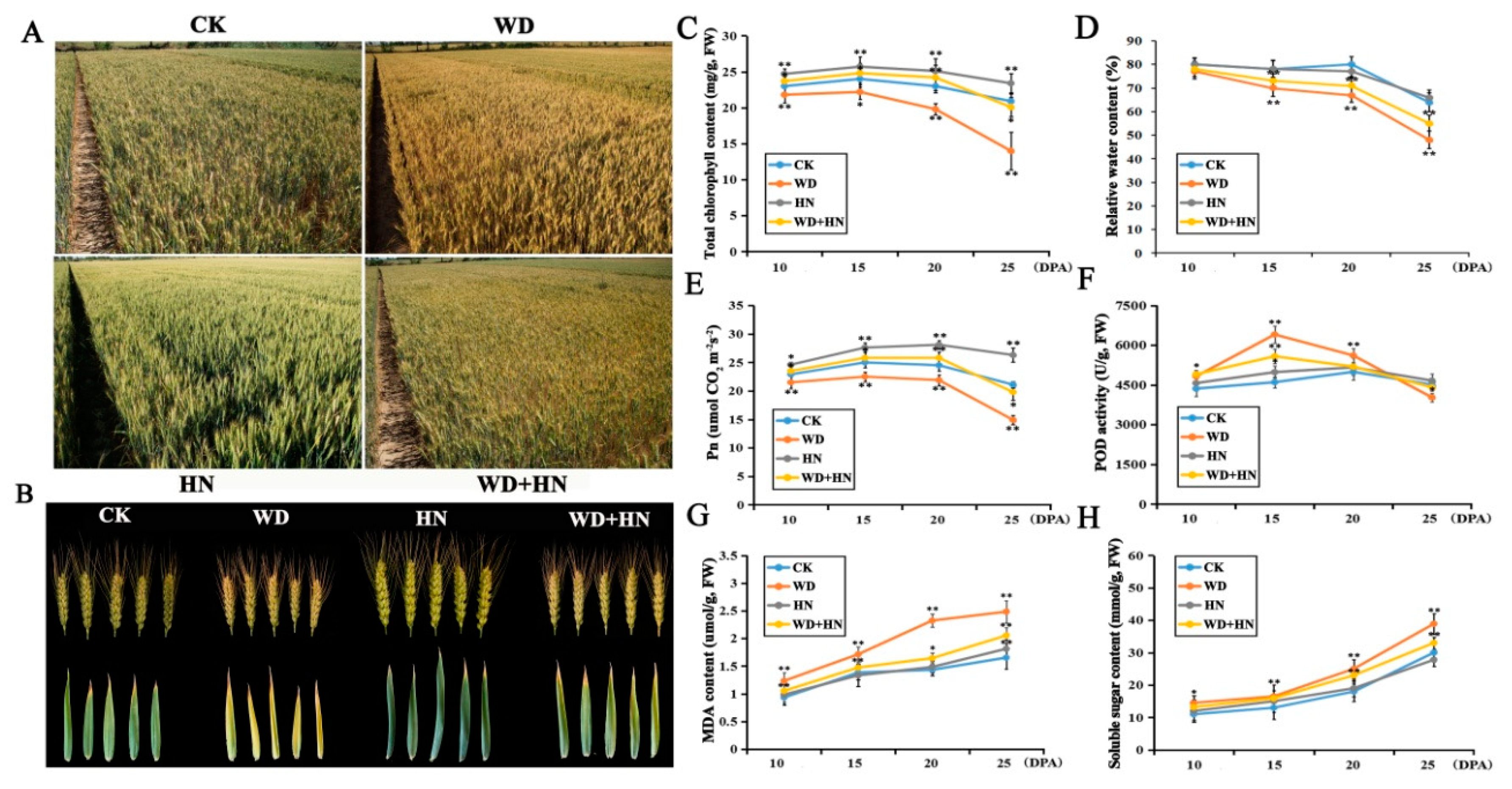

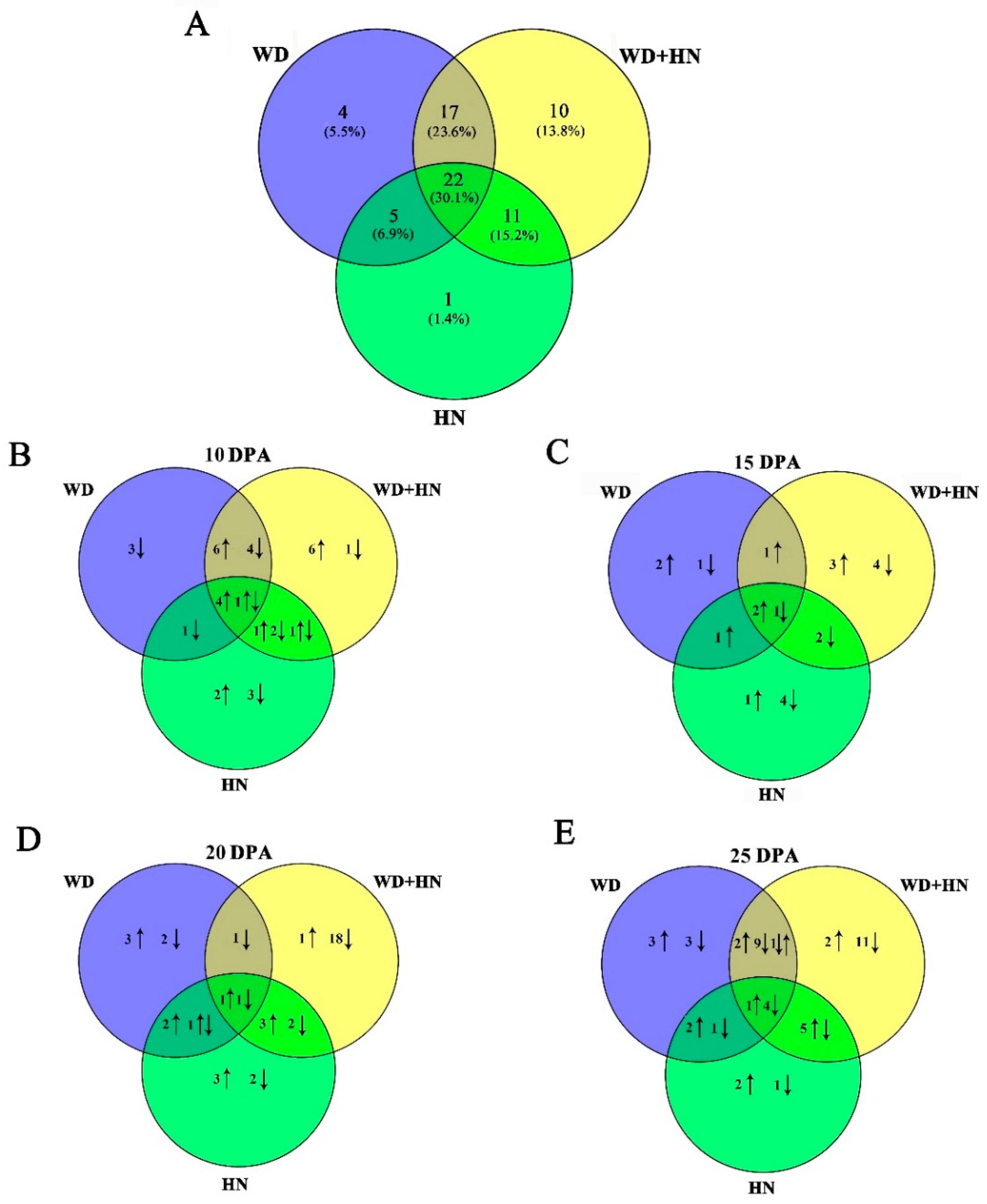

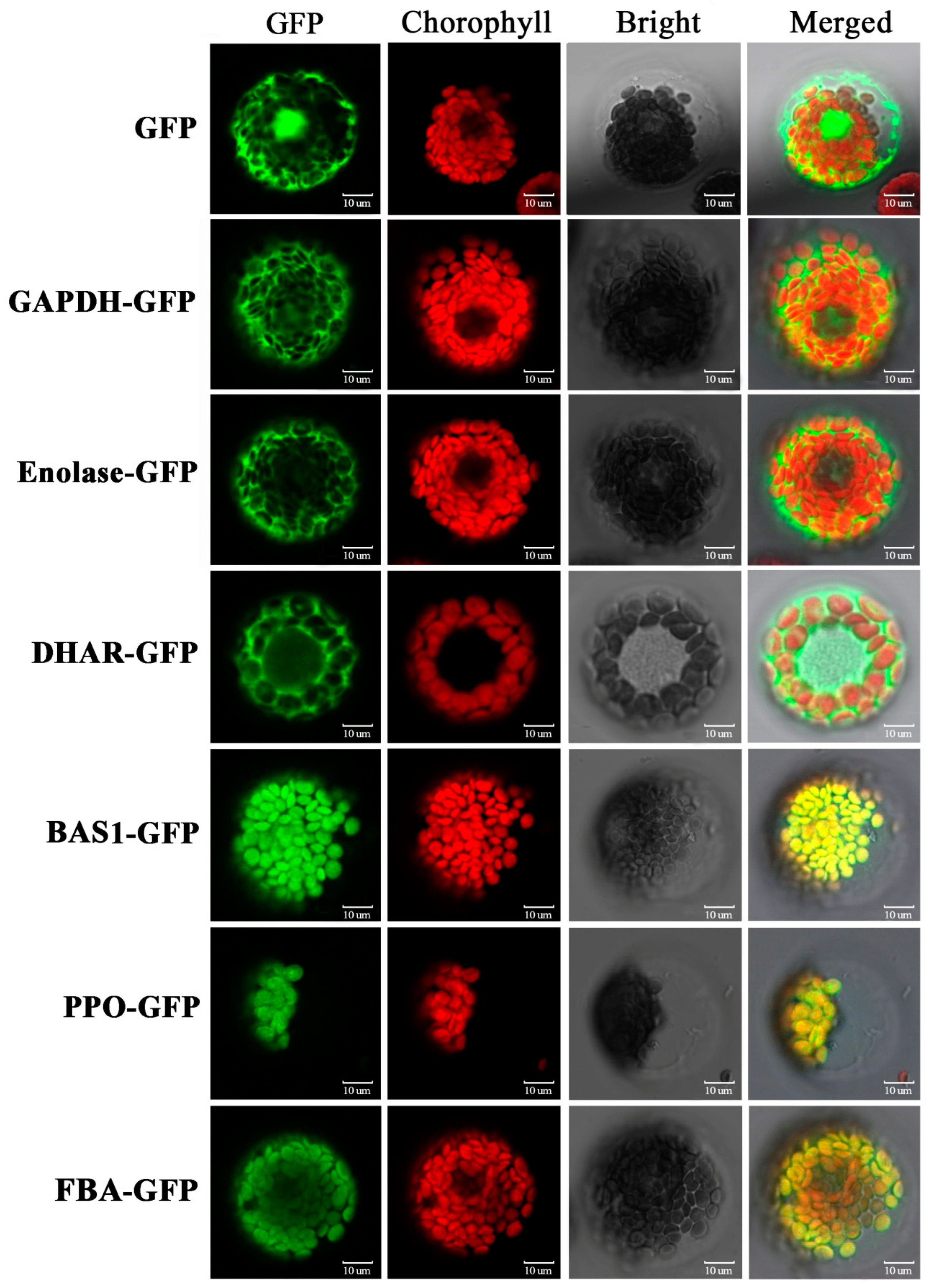
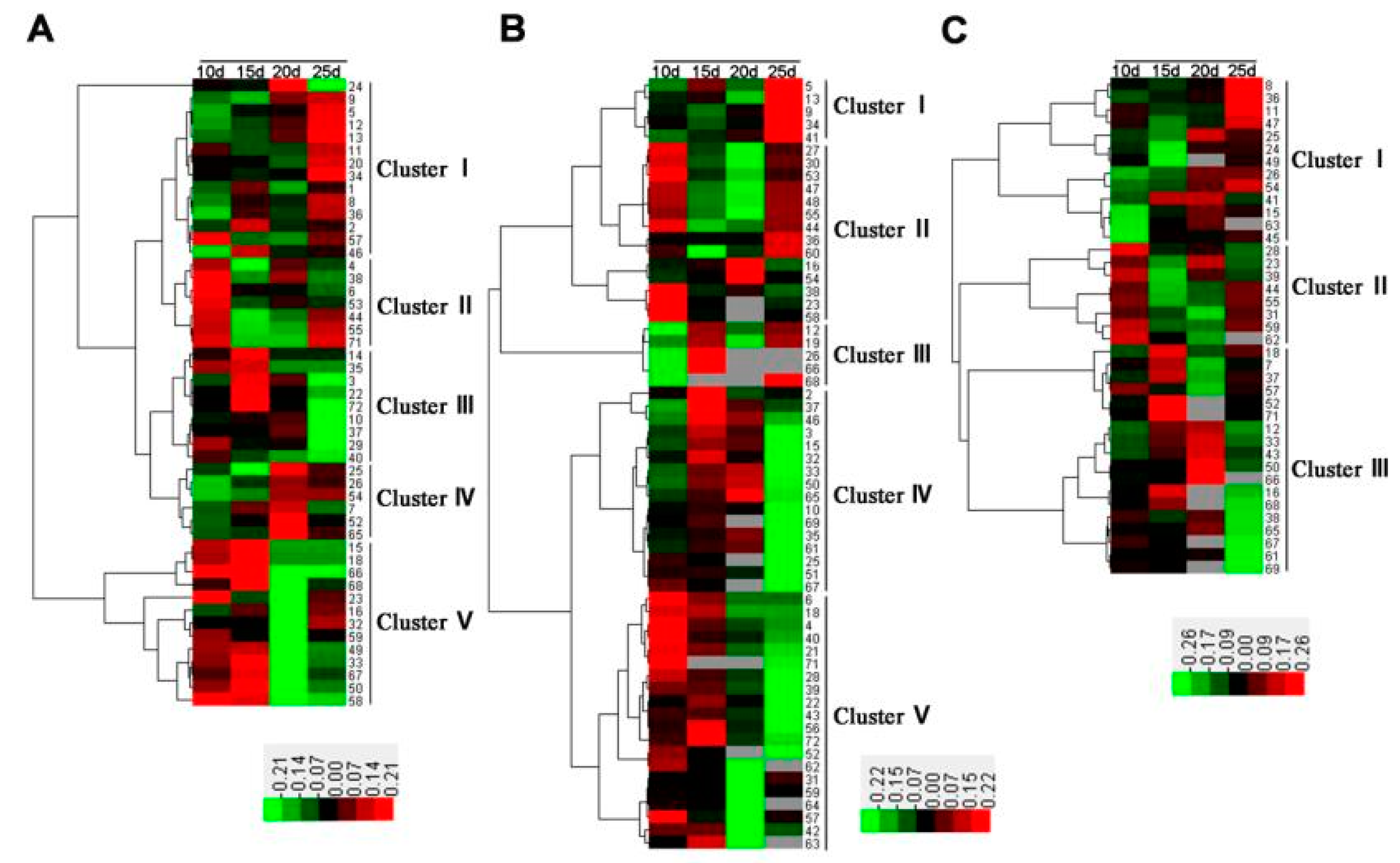
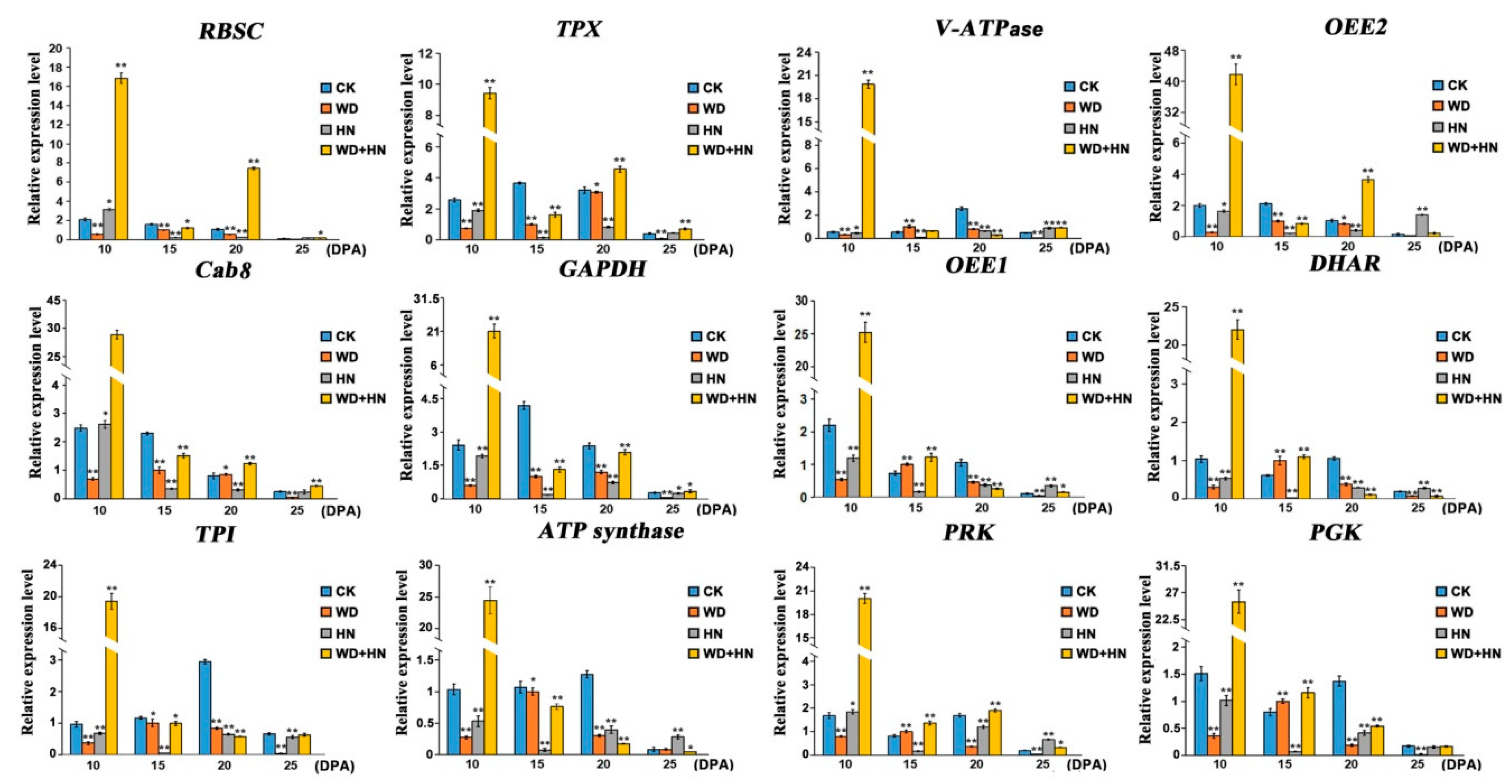
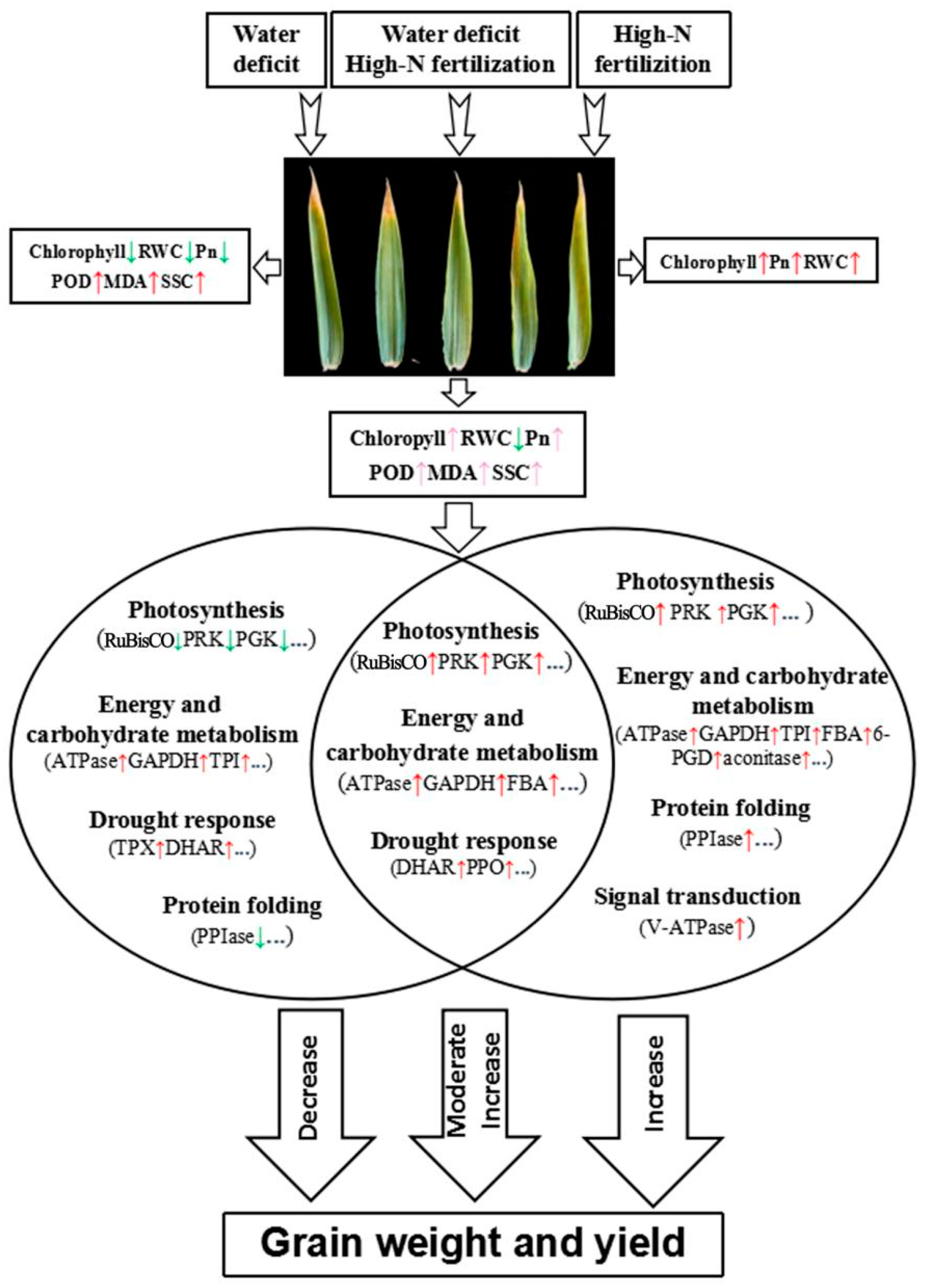
| Spot No. | Protein Name | Water-Deficit Treatment (10/15/20/25 DPA) | High-N Fertilizer Treatment (10/15/20/25 DPA) | Combined Treatment (10/15/20/25 DPA) |
|---|---|---|---|---|
| Signal transduction | ||||
| 8 | Vacuolar proton-ATPase | −25%/+22%/−2%/+1% | −17%/−4%/−11%/+81% | +38%/−12%/+14%/+105% |
| Redox homeostasis and stress defense | ||||
| 5 | Thioredoxin-dependent peroxidase | −47%/+9%/+11%/+111% | −20%/+24%/−16%/+112% | +36%/+9%/+3%/+24% |
| 7 | Germin-like protein | −18%/+81%/+101%/−24% | −7%/−20%/−24%/+15% | −4%/+103%/−49%/−12% |
| 25 | Dehydroascorbate reductase | +41%/−59%/+112%/+12% | +32%/+12%/−100%/−59% | −3%/−15%/+101%/+31% |
| 52 | Polyphenol oxidase | +63%/+21%/−15%/+27% | +17%/+18%/−15%/−100% | +43%/+113%/−100%/+32% |
| Carbohydrate metabolism | ||||
| 34 | Glyceraldehyde-3-phosphate dehydrogenase B | −36%/−47%/-40%/+133% | −21%/−40%/−26%/+118% | −34%/−33%/−21%/+89% |
| 26 | Triosephosphate isomerase | −37%/−6%/+108%/+42% | −69%/+101%/−100%/−100% | −47%/−23%/+36%/+28% |
| 37 | Fructose-1,6-bisphosphate aldolase | +21%/+18%/+59%/−87% | −45%/+151%/+19%/−43% | −35%/+102%/−69%/+115% |
| 38 | 6-phosphogluconate dehydrogenase | +134%/−38%/+67%/+33% | +153%/−24%/−8%/−35% | +76%/+2%/+74%/−69% |
| 55 | Aconitase | +130%/−41%/−29%/+133% | +13%/−59%/−77%/+53% | +43%/−55%/−13%/+35% |
| Energy metabolism | ||||
| 30 | ATP synthase subunit | +80%/−15%/−21%/+54% | +121%/+37%/+73%/+118% | −19%/−28%/−22%/+14% |
| 47 | ATP synthase CF1 alpha subunit | +36%/−20%/−38%/+3% | +109%/−46%/−75%/+89% | −14%/−45%/−37%/+128% |
| 48 | ATP synthase CF1 alpha subunit | −5%/−39%/+30%/−8% | +76%/−32%/+64%/+54% | +34%/+43%/+4%/−5% |
| 53 | ATP synthase CF1 alpha subunit | +101%/−22%/+11%/−14% | +122%/−24%/−54%/+35% | +18%/−29%/−49%/+2% |
| 44 | ATP synthase CF1 alpha subunit | +121%/−48%/−11%/+97% | +104%/+54%/−62%/+35% | +20%/−54%/−35%/+23% |
| 45 | ATP synthase CF1 beta subunit | −4%/−5%/−42%/−33% | −14%/+20%/−41%/−20% | −76%/+7%/+3%/+27% |
| Photosynthesis | ||||
| 1 | Ribulose-1,5-bisphosphate carboxylase/oxygenase small subunit | −21%/+52%/−59%/+1% | −16%/+38%/−26%/+4% | +35%/−12%/−1%/+4% |
| 4 | Ribulose-1,5-bisphosphate carboxylase/oxygenase small subunit | −64%/−63%/+24%/−16% | +238%/+14%/−20%/−35% | +17%/−13%/+50%/−38% |
| 23 | Ribulose-1,5-bisphosphate carboxylase/oxygenase small subunit | +119%/−45%/−89%/+1% | +130%/+13%/−100%/−11% | +54%/−51%/−100%/−34% |
| 40 | Ribulose-1,5-bisphosphate carboxylase/oxygenase large subunit | +67%/−13%/−52%/−55% | +119%/+4%/−10%/−30% | −4%/−20%/+43%/−37% |
| 41 | Ribulose-1,5-bisphosphate carboxylase/oxygenase large subunit | −20%/+82%/+8%/−25% | −35%/−18%/+5%/+110% | −46%/+101%/+111%/−12% |
| 60 | Ribulose-1,5-bisphosphate carboxylase/oxygenase large subunit | +26%/−18%/+33%/−1% | +8%/−68%/−20%/+101% | +7%/−49%/−27%/−8% |
| 11 | Oxygen-evolving enhancer protein 2, chloroplastic | +35%/−0.11%/−8%/+111% | +15%/−20%/−36%/+63% | +10%/−14%/−11%/+140% |
| 12 | 23kDa oxygen evolving protein of photosystem II | −52%/−35%/+74%/+48% | −61%/+12%/−45%/+5% | −45%/+1%/+20%/−54% |
| 24 | Oxygen-evolving enhancer protein 1 | +5%/+1%/+131%/−70% | -40%/−41%/−22%/+4% | +65%/−59%/+28%/+2% |
| 32 | Phosphoribulokinase | −12%/−13%/−100%/+31% | −28%/+102%/−22%/−37% | −15%/−3%/−26%/+52% |
| 33 | Phosphoribulokinase | +41%/+81%/−86%/-62% | -45%/+27%/+102%/-89% | −23%/+65%/+111%/−33% |
| 36 | Phosphoglycerate kinase | −59%/+8%/−23%/+48% | −12%/+9%/−19%/+115% | −36%/+1%/−25%/+101% |
| 13 | Chlorophyll a-b binding protein 8 | −18%/−19%/+26%/+309% | −36%/+10%/−31%/+134% | +3%/+8%/−4%/+35% |
| 14 | Chlorophyll a-b binding protein 8 | +6%/+111%/−13%/−12% | +29%/+46%/+17%/−14% | −30%/+15%/+12%/+10% |
| 29 | Photosystem II stability/assembly factor HCF136 | +40%/−11%/−1%/−89% | +12%/+11%/0%/−13% | +14%/−23%/+63%/+84% |
| 54 | NADP-dependent malic enzyme | −84%/−68%/+33%/+31% | −26%/−2%/+394%/+1% | −43%/−48%/+21%/+101% |
| Amino acid metabolism and protein folding | ||||
| 2 | Putative glycine decarboxylase subunit | −16%/+137%/−1%/+26% | −4%/+133%/−19%/−10% | +41%/+16%/−26%/+41% |
| 43 | Leucine aminopeptidase 2 | −27%/+12%/+64%/−18% | +24%/+28%/−48%/−79% | −49%/+27%/+116%/−11% |
| 9 | Peptidyl-prolyl cis-trans isomerase 2 | −32%/−52%/+28%/+66% | −7%/−19%/+1%/+101% | +6%/−15%/+74%/+52% |
| 15 | ATP-dependent Clp protease proteolytic subunit | +41%/+101%/−53%/−52% | −49%/+24%/+13%/−75% | −67%/−18%/+21%/+14% |
| 57 | ATP-dependent Clp protease ATP-binding subunit clpA-like protein | +238%/−12%/−21%/+67% | +215%/+21%/−66%/+58% | +26%/−8%/−61%/+19% |
© 2020 by the authors. Licensee MDPI, Basel, Switzerland. This article is an open access article distributed under the terms and conditions of the Creative Commons Attribution (CC BY) license (http://creativecommons.org/licenses/by/4.0/).
Share and Cite
Zhu, D.; Zhu, G.; Zhang, Z.; Wang, Z.; Yan, X.; Yan, Y. Effects of Independent and Combined Water-Deficit and High-Nitrogen Treatments on Flag Leaf Proteomes during Wheat Grain Development. Int. J. Mol. Sci. 2020, 21, 2098. https://doi.org/10.3390/ijms21062098
Zhu D, Zhu G, Zhang Z, Wang Z, Yan X, Yan Y. Effects of Independent and Combined Water-Deficit and High-Nitrogen Treatments on Flag Leaf Proteomes during Wheat Grain Development. International Journal of Molecular Sciences. 2020; 21(6):2098. https://doi.org/10.3390/ijms21062098
Chicago/Turabian StyleZhu, Dong, Gengrui Zhu, Zhen Zhang, Zhimin Wang, Xing Yan, and Yueming Yan. 2020. "Effects of Independent and Combined Water-Deficit and High-Nitrogen Treatments on Flag Leaf Proteomes during Wheat Grain Development" International Journal of Molecular Sciences 21, no. 6: 2098. https://doi.org/10.3390/ijms21062098
APA StyleZhu, D., Zhu, G., Zhang, Z., Wang, Z., Yan, X., & Yan, Y. (2020). Effects of Independent and Combined Water-Deficit and High-Nitrogen Treatments on Flag Leaf Proteomes during Wheat Grain Development. International Journal of Molecular Sciences, 21(6), 2098. https://doi.org/10.3390/ijms21062098






